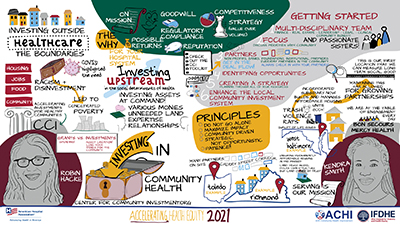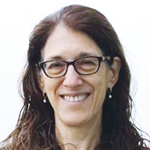By LISA EISENHAUER
A resource produced by the Center for Community Investment in partnership with CHA aims to help hospitals and health systems make investments that benefit their communities and provide returns that can generate more investments.

An illustration used by the Center for Community Investment shows the goals and principles behind investments in community health with examples from Bon Secours Mercy Health.
The partners released the 48-page investment guide called "Investing in Community Health: A Toolkit for Hospitals" last fall.
The toolkit:
- Defines community investment.
- Explains how health care organizations can integrate community investment into their community health improvement strategies.
- Explores how health care organizations can create a community investment strategy.
"The scale of transformation that we're after in our communities is just too big to be achieved by grants or by government subsidies alone," said Robin Hacke, executive director of the Center for Community Investment. "Anchor institutions and community partners really need to deploy all of the assets that we have — financial investments, land and grant money — in order to make the difference that we're hoping to make."

Hacke
The center is a program within the Lincoln Institute of Land Policy, a nonprofit based in Cambridge, Massachusetts, that works to improve quality of life through the effective use, taxation and stewardship of land.
Hacke discussed the community investment toolkit in March during a session at the American Hospital Association's virtual Accelerating Health Equity conference. Kendra Smith, vice president of community health at Bon Secours Mercy Health, joined her in the discussion.
Bon Secours Mercy Health, CommonSpirit Health's Dignity Health and four other health systems or hospitals are part of the Center for Community Investment's Accelerating Investments for Healthy Communities program launched in February 2018. The program is advancing models for investments like those that the toolkit is designed to encourage.
Smith talked about investments Bon Secours Mercy Health has made in recent years that align with the system's mission of improving life for those in the communities where its facilities are located.
"At the very core of the work we do is making sure that we are serving the underserved, the poor and the dying and really having an opportunity to not just impact patients but really impact the communities that we serve," she said.
One of the three projects she spotlighted is Unity Properties in West Baltimore. The 802-unit project that provides affordable homes for families and seniors has been developed over the last 30 years. It is owned and operated by Bon Secours Mercy Health.
All of the units are within walking distance of Bon Secours Community Works. That social services center offers Head Start programming, employment skill building and financial counseling. The apartments and townhouses are near bus and rail transit, shopping, recreation and public green space.
"For us, maintaining this portfolio of housing has been a key innovative measure to spur other investment and other interest in this community," Smith said. "So now we see nonprofit organizations, we see small nonprofit developers, community lenders and community development financial institutions saying, 'How do we partner to grow this?'"
Finding reliable partners for community investment projects is one of the keys to success, Smith and Hacke said. The toolkit offers tips on how to identify potential partners, such as local faith communities, foundations and banks.
Julie Trocchio, senior director of community benefit and continuing care at CHA, said the toolkit can help Catholic health ministries build upon the community benefit work they already are doing.
"It's really, I think, a giant step forward for dealing with both equity and addressing the social determinants in our country because it's a way to be more creative at using the health systems' resources to improve the economic engine of a community," she said.
Investments, unlike grants, can't be counted toward the community benefit projects required of nonprofit health systems to meet federal mandates, Trocchio said. But unlike grants, investments provide financial returns that can fuel other projects.
Hacke said investments offer an additional option to grants, which are best used for things like salaries, child care subsidies and transit passes that don't provide any monetary return.
"What we're seeing is that by using investments, more dollars flow to making the kinds of long-term changes — like affordable housing, like access to fresh food — that we want to see in our communities," she said. "We can also, by using investment dollars where they're possible to use, save those precious grant dollars for the things like food banks and emergency relief that can't be funded in other ways."
The toolkit is available for download at centerforcommunityinvestment.org/resources.